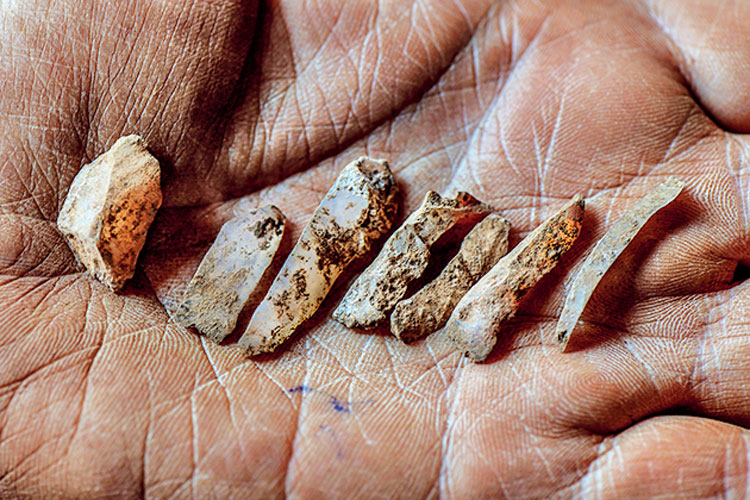In the evening breeze on a stony hilltop a day’s drive south of Mumbai, Sudhir Risbud tramped from one rock carving to another, pointing out the hull of a boat, birds, a shark, human figures and two life-size tigers.
“They’re male,” he said with a smile, noting that the carver had taken pains to make the genitalia too obvious to ignore. He was doing a brief tour of about two dozen figures, a sampling of 100 or so all etched into a hard, pitted rock called laterite that is common on the coastal plain that borders the Arabian Sea.
The carvings are only a sample of 1,200 figures that Risbud and Dhananjay Marathe, engineers and dedicated naturalists, have uncovered since they set out on a quest in 2012. The two men are part of a long tradition of amateur archaeologists, according to Tejas Garge, the head of the Directorate of Archaeology and Museums for the state of Maharashtra, and the petroglyphs they have uncovered amount to a trove of international significance. They are the most recent collection of rock art to join other images left by Stone Age peoples around the globe. Like paintings and carvings in Australia, the U.S. Southwest, Africa and elsewhere, the carvings are cryptic messages left by people whose lives are lost in the mists of deep time.
Garge estimates the oldest of the ground carvings are 10,000 to 40,000 years old, but dating such images is imprecise, particularly since rigorous study of the whole collection is just beginning.
Some of the images appear to relate to a life of hunting and gathering — deer, fish, turtles. Others depict animals of great power, like tigers and elephants. And there are humans, probably fertility figures, images of a mother goddess like those found elsewhere in India and around the world. The fertility images are usually accompanied by abstract designs, and some of the carvings are all abstract.
Even now, they can stir the emotions and the imagination the way they must have ages ago.

Small stone tools from the Mesolithic era found at excavation sites Picture: NYTNS
Some are worn, others still vivid, especially where they have been sprinkled with sand to fill the deep grooves. Garge said the state had earmarked about $3 million for preservation of the drawings and for research to narrow their age and try to learn about the people who made them. Unlike most other Stone Age rock carvings around the world, these images are not drawn on walls or standing rocks, but cut into the exposed stone of flat hilltops along what is called the Konkan coastal plateau. Their style is realistic for the animals, and more stylised for humans. Most of the animals, including elephants, are life-size and one site with multiple carvings is the largest in South Asia, Garge said. He believes it should be a national monument.
The discovery so far has not received a great deal of academic attention, but Jean Clottes, an expert on cave art and the editor of the International Newsletter on Rock Art, said in an email that the collection of images “is an important discovery, no doubt.” He said well-preserved carvings on the ground have been found elsewhere, but are unusual.
Meenakshi Dubey-Pathak, a freelance researcher and artist who has published extensively on Indian rock art said the carvings share imagery with other Indian rock art and rock art worldwide. “These were hunter gatherers,” she said and the carvings were not art for art’s sake. “They had meaning and purpose,” she said.
Indian tourists have been visiting the sites, since published reports of the epic journey of discovery by Risbud and Marathe first appeared last fall. But the sites are not easy to locate. You can find images on the tourism website for Ratnagiri, but there are no directions to or GPS locations for the various sites.
To find the carvings, a tourist needs to ask local town and village residents; Garge, Risbud and Marathe would like to keep it that way. Most of the carvings are on private land, and it would be costly to buy all the sites to preserve them. Garge hopes to make the sites a source of income to local residents.
He described an encounter with a tea seller who had a small stall at a crossroads near one of the sites. The state had considered putting up signs with directions, Garge said, but the tea seller asked him not to do so. People stop, they have at least a cup of tea and they ask directions, the tea seller told him. And his income has climbed as word of the carvings has gotten out. Now, Garge’s department is working on pilot projects for 15 sites to provide a comfortable viewing area with an elevated platform, a concession stand and a way for a village to sell tickets.
Some of the carvings were known to locals before Risbud and Marathe began their investigation. And researchers had done a study on one site in 1980. Amateur historians and some academics had written a bit about the few that had been identified. But it was only after the two engineers began to explore systematically and recruit other searchers, that the number and richness of the carvings became clear. Indian newspapers and the BBC reported on the extent of their finds last year.
Garge, whose specialty is historical archaeology, met the men after coming to Maharashtra in 2017. He visited some of the sites and appointed a member of his staff, Rhutvij Apte, to oversee research. Dating rock carvings is not easy, but there are clues, Garge said. One is that once agriculture appears, people carve images of bulls. There are no such images in the drawings from Maharashtra, he said, which feature every variety of wild animal, suggesting that these carvings were made by people who hunted and foraged for wild plants.
The next steps in research, he said, are to document each figure with drone photography, photographic mapping, and, if the budget permits, three-dimensional laser scans, so that if the carvings were lost to erosion or construction or mining of the laterite stone for brick, they could be recreated not only in outline, but in-depth, which can give an indication of carving technique.
Garge’s department will also be looking for evidence of the people who made the carvings. The figures are found only on windswept hills that are flooded during monsoons, places where there would have been no shelter. The carvers would have had to come to these places on purpose to make the drawings.
This year researchers began excavating a cave about 20 miles away and found microliths like those on the hilltops, as well as other, larger stone tools. “We are hoping to find more shelter sites in closer proximity to the petroglyphs,” Garge said.










